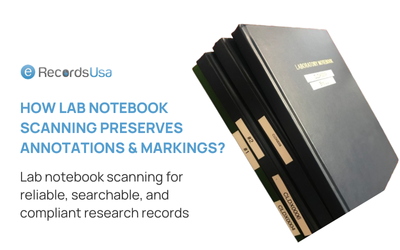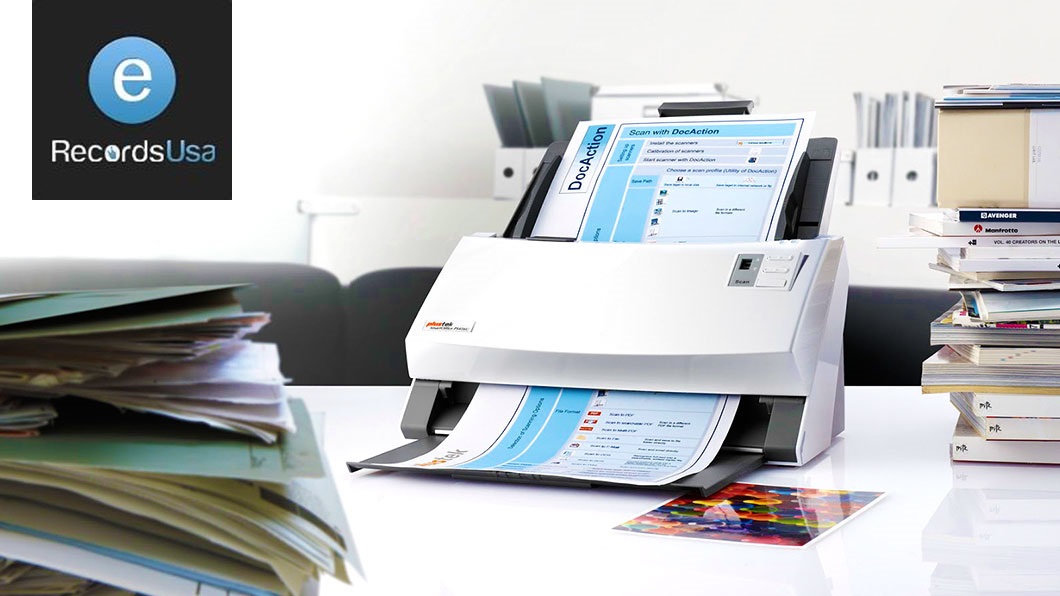What Happens When You Lose Important Handwritten Notes? Laboratory notebooks are more than just scientific records—they contain critical annotations, markings, and handwritten notes that capture real-time observations, experiment conditions, and insights that may not be present in typed documentation. However, during lab notebook scanning, improper digitization can lead to lost annotations, faded markings, or unclear handwritten notes, affecting research integrity and compliance.
Why Preserving Annotations Matters in Lab Notebook Scanning?
- Annotations provide context – Scientists jot down quick calculations, unexpected results, and key observations.
- Handwritten notes record real-time insights – These may never be transferred to formal reports.
- Markings highlight key findings – Symbols, underlines, and marginal notes guide future research.
- Preserving handwriting ensures research authenticity – Maintaining an unaltered, accurate digital version is crucial for patents, compliance, and reproducibility.
How This Guide Helps?
This article explains:
- Why annotations and markings are vital for research accuracy.
- Challenges labs face when scanning notebooks with handwritten content.
- The best technologies and practices for preserving these critical details.
- How to choose the right professional scanning service for research records.
If your lab relies on handwritten notes, preserving them during scanning is non-negotiable! Let’s explore how to do it right.
The Importance of Annotations and Markings in Lab Notebooks
Why Are Annotations and Markings Critical in Research Notebooks? Lab notebooks are scientific evidence—they document experiments, observations, and hypotheses in real time. Beyond structured entries, annotations, marginal notes, and markings capture spontaneous insights, procedural adjustments, and key findings that might never make it into official reports. Losing these details during lab notebook scanning can result in gaps in research continuity, errors in replication, and challenges in intellectual property claims.
1. The Role of Annotations in Lab Research
Annotations serve as cognitive footprints, allowing scientists to refine experiments, highlight discrepancies, and document deviations from planned methodologies.
Key Functions of Annotations in Lab Notebooks:
- Real-time Experiment Adjustments – Scientists modify protocols based on observed reactions.
- Calculations & Corrections – Handwritten equations and unit conversions refine data accuracy.
- Observational Notes – Color changes, temperature fluctuations, or unexpected reactions get documented.
- Cross-Referencing – Links to previous experiments or journal references aid future research.
- Team Collaboration – Multiple researchers annotate results, making teamwork more efficient.
Example: A chemical engineering team working on polymer synthesis notes an unexpected viscosity shift at 78°C and manually annotates this in the margin. If lost during scanning, the insight is erased, impacting further experiments.
2. The Impact of Losing Annotations During Scanning
When handwritten notes, underlined results, or marginal comments fail to appear in digitized lab notebooks, research suffers in multiple ways:
- Loss of Critical Experimental Insights – Important discoveries may go undocumented.
- Compromised Research Reproducibility – Future teams cannot replicate exact procedures.
- Intellectual Property & Patent Risks – Handwritten timestamps and signatures authenticate invention timelines.
- Regulatory Compliance Issues – Missing documentation can lead to non-compliance with FDA, GLP, or ISO standards.
Example: A biotech startup filing a patent must prove the first recorded occurrence of an experiment. If marginal annotations—documenting the initial discovery date—are not retained during scanning, legal challenges may arise.
Why Accurate Annotation Retention is Non-Negotiable?
- Ensures that no scientific detail is lost
- Protects intellectual property and legal claims
- Maintains compliance with research and industry standards
- Facilitates collaboration and research continuity
Next, we’ll explore the challenges labs face when trying to preserve handwritten notes and markings during scanning.
Challenges in Retaining Annotations and Markings During Scanning
Why Do Some Annotations Disappear During Lab Notebook Scanning? Scanning lab notebooks isn’t just about digitizing text—it involves preserving handwritten notes, margin annotations, faded ink, and scientific symbols without losing detail. Many labs struggle with scanning errors that result in missing or unreadable annotations, leading to gaps in research documentation.
Let’s explore the biggest challenges in preserving handwritten records, margin notes, and aged paper markings—and why standard scanning methods often fail.
| Challenge | Why It Happens | Solution |
|---|---|---|
| ✍️ Handwritten Notes: The Risk of Faded or Unreadable Text | 🔹 Light pencil or faded ink may not be recognized by scanners. 🔹 Fast, informal handwriting can be blurry or illegible in digitized formats. 🔹 Traditional OCR struggles with complex scientific notations, Greek symbols, and formulas. |
✅ Use high-contrast scanning modes. ✅ Implement AI-powered OCR capable of detecting handwritten text. |
| 📜 Damaged or Aged Notebooks: Preserving Fragile Pages | 🔹 Yellowed, brittle pages absorb light unevenly, causing contrast issues. 🔹 Ink bleeding through pages results in double-image distortions. 🔹 Torn or folded pages block handwritten text, leading to missing information. |
✅ Use specialized archival scanning techniques. ✅ Adjust lighting and apply grayscale enhancement for better readability. |
| 📝 Annotations in Margins: Risk of Being Cropped or Ignored | 🔹 Scanning software often focuses only on the central text, ignoring margins. 🔹 Annotations close to the page edge may be cut off by automated alignment. 🔹 Light ink or small handwriting may not be detected in margin areas. |
✅ Use full-page high-resolution scanning. ✅ Adjust settings to capture edge content without cropping. |
Why These Challenges Matter in Research Documentation?
- Missing handwritten data compromises research reproducibility.
- Loss of faded ink, margin notes, or scientific symbols weakens legal and intellectual property claims.
- Regulatory non-compliance risks increase if digital records are incomplete.
Next, we’ll explore the advanced scanning technologies that help preserve annotations and markings accurately.
Technologies That Help Preserve Annotations and Markings
How Can Advanced Scanning Technologies Retain Handwritten Notes & Annotations? Traditional scanning methods often fail to capture faded ink, margin notes, and handwritten calculations, leading to lost research data. To preserve every detail of lab notebooks—including delicate annotations and markings—labs must use advanced scanning technologies designed for scientific documentation.
Here are the key scanning technologies that ensure accurate retention of all handwritten details.
1. High-Resolution Scanning: Capturing Every Detail
What It Does:
- Uses ultra-high DPI (dots per inch) settings (600–1200 DPI) to capture fine handwriting, faded ink, and intricate markings.
- Ensures sharp contrast for pencil notes and light ink annotations.
- Reduces blurring or pixelation in scientific diagrams and marginal notes.
Best For: Research notebooks with fine-pen, pencil, or lightly marked annotations.
2. Optical Character Recognition (OCR) for Handwritten Notes
What It Does:
- Uses AI-powered OCR to recognize and digitize handwritten text and scientific symbols.
- Converts handwritten notes into searchable, indexed digital files.
- Detects Greek letters, chemical formulas, and mathematical equations often used in scientific research.
Best For: Labs needing searchable and indexed digital records of handwritten content.
3. Multi-Spectral & Contrast-Enhancing Scanners
What It Does:
- Uses infrared and ultraviolet light to reveal faded or obscured text.
- Enhances contrast in aged or damaged notebooks to restore legibility.
- Prevents loss of marginal notes, light pencil markings, and annotations on degraded paper.
Best For: Archival and long-term research documentation where faded text must be restored.
4. Edge Detection & Full-Page Capture for Margin Annotations
What It Does:
- Prevents margin cropping, ensuring handwritten notes outside main text areas are preserved.
- Uses AI-driven alignment correction to capture text close to the edges of pages.
- Eliminates scanner software auto-cropping that trims out handwritten notes in margins.
Best For: Labs with scientists who write critical notes in margins or page corners.
Why Investing in Advanced Scanning Technologies Matters?
- Ensures all handwritten research data is retained, preventing loss of critical insights.
- Enables accurate searchability with OCR and AI indexing for scientific notes.
- Meets compliance and legal documentation standards for patent protection and audits.
- Improves data integrity for long-term scientific archiving and knowledge preservation.
Next, we’ll explore the best practices labs should follow to maximize annotation retention during scanning.
Best Practices for Preserving Annotations During Scanning
How Can Labs Ensure Every Handwritten Note is Retained? Even with advanced scanning technology, improper setup or handling can result in blurred text, missing margin notes, or faded ink loss. To maximize accuracy, readability, and compliance, labs must follow best practices when digitizing handwritten lab notebooks.
1. Choosing the Right Equipment: High-Resolution & AI-Powered Scanners
Why It Matters:
- Standard office scanners lack the precision needed for detailed lab notebooks.
- High-resolution 600–1200 DPI scanning ensures fine details are captured clearly.
- AI-powered OCR scanners detect handwritten notes, including chemical symbols and formulas.
Best Practice: Always opt for scientific-grade or archival-quality scanners that capture fine ink strokes, light pencil annotations, and scientific diagrams.
2. Pre-Scanning Preparation: Handling Notebooks Properly
Why It Matters:
- Flatten notebook pages to prevent shadows and distortions.
- Clean fragile pages carefully to remove dust or ink smudges that interfere with scanning.
- Check for ink fading—if text is too light, consider pre-enhancing it for readability.
Best Practice: Handle old or fragile lab notebooks with care to prevent ink loss or page degradation during scanning.
3. Setting Optimal Scanning Parameters: Ensuring Maximum Clarity
Why It Matters:
- Use grayscale mode to enhance faded annotations while preserving contrast.
- Enable edge detection to prevent cropping out margin notes or handwritten edits.
- Adjust brightness and contrast settings to bring out light pencil or ink text.
Best Practice: Test scan a sample page first to fine-tune brightness, contrast, and DPI settings before scanning an entire notebook.
4. Verifying Scanned Output: Ensuring Annotation Accuracy
Why It Matters:
- Review each scanned notebook for missing handwritten notes or incomplete pages.
- Compare digital and physical copies to confirm that annotations are fully retained.
- Re-scan problematic pages with enhanced settings if any markings are unclear.
Best Practice: Implement a quality control process to verify that every annotation, marking, and handwritten entry is digitally captured.
Why Following Best Practices Ensures Research Integrity?
- Retains all handwritten notes, annotations, and critical scientific markings.
- Prevents scanning errors that could result in lost research insights.
- Ensures compliance with research documentation and patent protection standards.
- Improves long-term searchability and usability of digitized research records.
Next, we’ll explore the benefits of preserving annotations and markings in lab notebook scanning.
Benefits of Preserving Annotations and Markings
Why Is It Critical to Retain Handwritten Notes in Digitized Lab Notebooks? Annotations and markings in lab notebooks are more than just scribbles—they provide context, experimental adjustments, and intellectual property evidence. When labs invest in proper scanning techniques to preserve these details, they unlock significant advantages in research integrity, legal protection, and regulatory compliance.
| Category | Key Benefit |
|---|---|
| 📜 Accurate Record Keeping: Ensuring Data Integrity | Retaining handwritten notes ensures that scientific records remain complete and accurate for decades. |
| 🔏 Intellectual Property Protection: Proving Research Ownership | Proper annotation preservation strengthens intellectual property claims and patent applications. |
| ⚖️ Regulatory Compliance: Meeting Documentation Standards | Properly scanned annotations help labs meet compliance requirements and avoid legal complications. |
Why Preserving Annotations and Markings Is Essential?
- Ensures long-term data accuracy and research reproducibility.
- Strengthens intellectual property and patent protection.
- Meets global compliance standards for scientific documentation.
- Enhances research efficiency and collaboration by retaining real-time notes.
Next, we’ll explore how to choose the right scanning service to ensure all annotations and markings are preserved.
How to Choose the Right Scanning Service for Annotation Preservation?
What Should You Look for in a Professional Lab Notebook Scanning Service? Not all scanning services are equipped to preserve annotations, handwritten notes, and marginal markings effectively. Choosing the right service ensures that every detail in your lab notebooks is accurately digitized, preventing data loss and compliance risks.
Here’s what to consider when selecting a professional scanning service for lab notebooks.
| Key Factor | Why It Matters | Example | What to Look For |
|---|---|---|---|
| 📷 Professional Equipment: High-Resolution and AI-Powered Scanning | ✅ Standard office scanners lack the precision needed for scientific notebooks. ✅ High-resolution (600–1200 DPI) imaging ensures every detail is captured. ✅ AI-powered handwriting recognition (OCR) enhances searchability of handwritten notes. |
A pharmaceutical company working on drug stability testing selects a scanning service that offers 1200 DPI high-resolution imaging to capture fine-ink annotations in aging lab notebooks. | 🔸 High-resolution scanning (minimum 600 DPI). 🔸 OCR technology with handwriting recognition. 🔸 Specialized lab notebook scanning equipment. |
| 📚 Experience with Research Materials: Handling Scientific Notebooks with Care | ✅ Lab notebooks contain delicate pages, historical records, and sensitive data. ✅ A professional service should understand how to handle aged, fragile, or complex scientific documents. ✅ Specialized scanning methods prevent page distortion, ink fading, and data loss. |
A university research archive digitizing 50 years of environmental field notes chooses a scanning service experienced in preserving fragile documents, ensuring no margin notes or faded ink markings are lost. | 🔸 Expertise in scanning research and laboratory materials. 🔸 Safe handling techniques for fragile or aged lab notebooks. 🔸 Experience with regulatory and archival compliance. |
| ⚙️ Custom Solutions: Tailored Scanning for Lab Notebook Needs | ✅ Every lab has different needs—some require full-color scanning, while others prioritize OCR indexing. ✅ Custom settings like contrast enhancement, multi-spectral imaging, and edge detection help capture marginal annotations and scientific symbols. ✅ The service should offer metadata tagging for easy retrieval of experiments, researchers, and dates. |
A genetics lab scanning DNA sequencing notebooks works with a scanning service that offers custom contrast adjustments, ensuring even light pencil annotations remain visible in the final digital archive. | 🔸 Custom scanning settings (grayscale, contrast adjustment, edge detection). 🔸 Metadata tagging for searchability. 🔸 Full-page capture to prevent margin cropping. |
Why Choosing the Right Scanning Service Matters?
- Ensures accurate retention of handwritten notes and annotations.
- Prevents loss of intellectual property and critical research insights.
- Meets compliance standards for regulated industries.
- Improves long-term accessibility and searchability of digitized records.
Next, we’ll conclude with how our solutions can help preserve your lab notebook annotations and markings.
How Can We Help?
Is Your Lab Notebook Scanning Process Preserving Every Critical Detail? Accurate preservation of handwritten annotations, margin notes, and scientific markings is essential for research integrity, intellectual property protection, and regulatory compliance. Without the right scanning approach, your lab’s critical insights could be lost forever.
We specialize in high-resolution, AI-powered scanning solutions designed to retain every detail in your lab notebooks—ensuring that your research remains searchable, compliant, and legally protected.
Why Choose Us for Your Lab Notebook Scanning?
- Precision Scanning with High-Resolution Imaging (600–1200 DPI)
- Captures even light ink, pencil markings, and scientific symbols without distortion.
- AI-Powered OCR for Handwritten Notes & Scientific Annotations
- Converts handwritten text, calculations, and formulas into searchable data.
- Custom Scanning Solutions for Research Labs & Archives
- Grayscale enhancement, multi-spectral scanning, and edge detection ensure every annotation is retained.
- Regulatory Compliance & Data Integrity Assurance
- Meets FDA (21 CFR Part 11), GLP, and ISO standards for legal and research documentation.
- Safe Handling of Fragile, Historical, and Specialized Research Materials
- Expertise in preserving aged lab notebooks without ink loss or page distortion.
Let’s Future-Proof Your Lab Records with eRecordsUSA
- Ensure every handwritten note, annotation, and research insight is preserved with precision.
- Make your scanned lab notebooks fully searchable, compliant, and accessible anytime, anywhere.
Get in touch with us today—your partner in secure, high-fidelity lab notebook digitization!














